![]()
![]()
![]()
Use LEFT and RIGHT arrow keys to navigate between flashcards;
Use UP and DOWN arrow keys to flip the card;
H to show hint;
A reads text to speech;
27 Cards in this Set
- Front
- Back
|
what is the most important motor tract in humans and what are its components?
|
the pyramidal tract which is made of the pyramid of the medulla, basillar pons, and cerebral peduncle
|
|
|
all motor pathways beside the pyramidal tract pass through what to reach lower centers?
|
tegmentum
|
|
|
all sensory (ascending) pathways pass through what to reach the higher centers?
|
tegmentum
|
|
|
1. cerebellum
2. tectum 3. cerebral peduncle 4. basilar pons 5. pyramid 6. tegmentum |
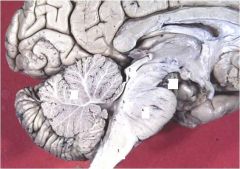
label
|
|
|
what is the oldest part of the brain, where is it found, and what are its functions?
|
the reticular formation which is located in the tegmentum and is involved in nearly every aspect of brain function including homeostasis, consciousness, arousal, pain, primitive motor control, muscle tone and behavioral mechansims
|
|
|
the reticular formation is continuous functionally and structurally with what area of the spinal cord?
|
the intermediate zone in the gray matter
|
|
|
vital centers are located where in the reticular formation?
|
in the medulla and pons (tegmental part)
|
|
|
reticular formation mediated reflexes include what?
|
aortic body, carotid body, aortic sinus, carotid sinus, respiratory, cough, swallowing, salivary, vomiting
|
|
|
the midbrain reticular formation give rise to to a tonic ascending barrage of diffuse non specefic sensory data called what? what is its function? what type of NT does it use?
|
the ascending reticular activating system AKA ARAS which acts like a battery stimulating the cortex to maintain conscious state. Its axons are cholinergic
|
|
|
what areas of the brain enhance or diminish a broad spectrum of activities (mood, arousal, behavior, sleep, muscle tone, responsiveness, learning, pain, pleasure, and motivation)via what kinds of NT's?
|
monamine centers which have specefic monamine NT's
|
|
|
what are the three monamine centers in the brain stem? NT's? locations?
|
the locus ceruleus uses NE and is in the rostral (tegmental part) of pons. the sibstantia nigra and ventral tegmental area use DA and are located in the tegmental part of the midbrain. The raphe nucleus uses serotonin and is found in the tegmental area of the medulla, pons, and midbrain
|
|
|
why do the monoamine centers appear pigmented?
|
the monamine NT's have melanin as a by product
|
|
|
cranial nerve nuclei are located where and oriented how?
|
arranged in longitudinal columns in the posterior tegmentum
|
|
|
which nuclei are more distal in the horns of the spinal cord?
|
the GSA in the posterior and the GSE in the anterior
|
|
|
what type of neurons make up nuclei of destination? of origin?
|
destination nuclei are synapsed upon by afferents while origin nuclei are efferents that send messages down their own axons
|
|
|
spinal nuclei are arranged how?
|
continuous longitudinal columns
|
|
|
in the brainstem, how are the motor and sensory nuclei of cranial nerves arranged?
|
motor are medial while sensory are more lateral
|
|
|
cranial nerve nuclei are located where in relation to the level of the nerve itself?
|
on the same level except the sensory nuclei of the trigeminal nerve.
|
|
|
cranial nerves must travel from their nuclei through what structure to enter or exit anteriorly?
|
the tegmentum
|
|
|
1. occulomotor
2. trochlear 3. abducens 4. hypoglossal |
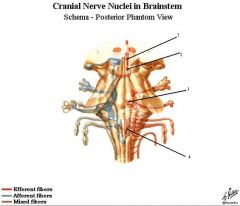
label the GSE nuclei
|
|
|
1. trigeminal
2. facial 3. glossopharyngeal and vagus (nucleus ambigus) |
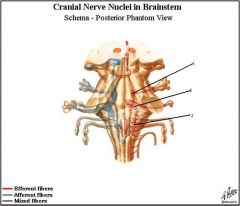
label the SVE nuclei
|
|
|
1. occulomotor (edinger westphal)
2. facial (superior salivatory nu) 3. glossopharyngeal (inferior salivatory nu) 4. vagus (dorsal motor nu) |
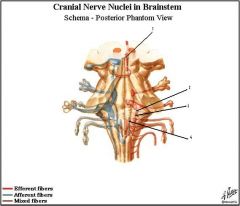
label the GVE nuclei
|
|
|
where is the only GVA cranial nerve nuclei and what nerves synapse on it? what is another name for this nucleus?
|
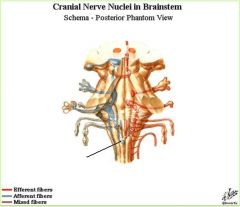
facial, glossopharyngeal, and vagus all synapse on the nucleus solitarius
|
|
|
what and where are the two SVA cranial nerve nuclei and what nerves synapse on them?
|
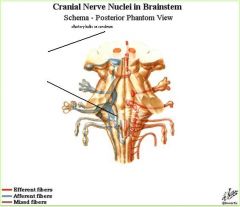
the olfactory bulb and the nucleus solitarius (includes gustatory nucleus for taste). the facial, glossopharyngeal, and vagus all synapse on the solitarius/gustatory while the olfactory nerves synapse on the olfactory bulb
|
|
|
1. mesencephalic (trigem only)
2. chief nucleus (trigem and facial) 3. spinal (glossopharyngeal, vagus, and trigem) |
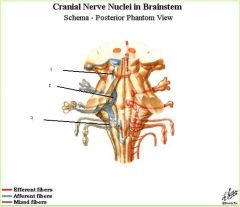
what are the three divisions of the GSA nuclei (trigeminal complex) and what nerves synapse on these parts
|
|
|
1. optic nerve tracts (not really nuclei, project to the thalamus)
2. vestibular nuclei (vestibular cochlear nerve) 3. cochlear nuclei (vestibulocochlear nerve) |
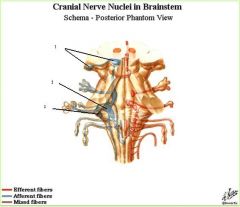
label the SS nuclei and say what nerves synapse on them.
|
|
|
the optic nerve projects to what nucleus in the thalamus?
|
lateral geniculate nucleus
|

